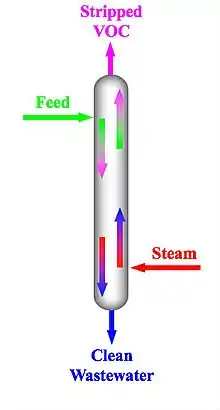
Diagram of how to economically clean up plant wastewater streams. Steam is use as a stripping gas to remove hydrocarbons from the waste water.
Steam stripping is a process used in petroleum refineries and petrochemical plants to remove volatile contaminants, such as hydrocarbons and other volatile organic compounds (VOCs), from wastewater.[1][2] It typically consists of passing a stream of superheated steam through the wastewater.
This method is effective when the volatile compounds have lower boiling points than water or have limited solubility in water.
References
- ↑ Beychok, M.R., The Design of Sour Water Strippers, Individual Paper 61, Proceedings of Seventh World Petroleum Congress, Mexico City, April 1967
- ↑ Kister, Henry Z. (1992). Distillation Design (1st ed.). McGraw-Hill. ISBN 0-07-034909-6.
This article is issued from Wikipedia. The text is licensed under Creative Commons - Attribution - Sharealike. Additional terms may apply for the media files.